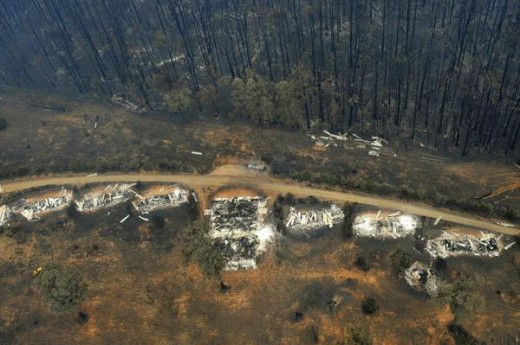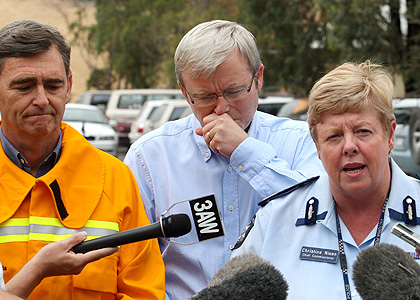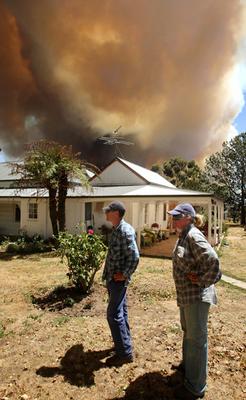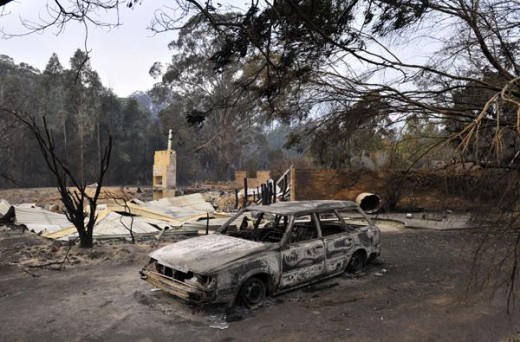Victorian Bushfires: ‘Gross Emergency Neglect’
.
 A forgotten victim of bushfire
A forgotten victim of bushfire
.
The analogy of the Titanic ocean liner disaster of 15th April 1912 is apt in relation to rural communities entrusting those in charge to be able to deal with public/national emergencies. The public trusted the Titanic met government standards. But 2,223 people boarded and 1514 died from the iceberg collision. Government standards were later revealed as substandard.
Public trust in government is appropriate (it’s why we pay our bloody taxes), but government systemically neglects its responsibility and abuses that public trust. Government has the nerve to entice volunteer members of the community to do its dirty work – aka the CFA. So individuals have given up on their government to be able to respond adequately to emergencies (bushfires, floods, droughts, etc) feel compelled to take measures themselves. Building a bunker is a vigilante response. I’m not saying its not a constructive response, but it is a consequential reaction of government failing to protect bushfire-prone communities. It’s like residents losing faith in the police and feeling compelled to being vigilantes. It’s akin to Titanic passengers bringing along their own liferafts.
.
To attribute blame on climate change ignores the role of government and in the case of the 2009 Victorian Bushfires lets government get away with manslaughter – literally.
Look into the history of the causes of the Titanic sinking and one can draw many comparisons with the failures of Emergency Management Australia in how it failed to protect life, property and ecological values from the bushfires across Victoria last January and February. The root causes of the (a) 1914 Titanic’s sinking and (b) the loss of 1514 lives were: management culture, poor contingency planning, design flaws, poor governance (e.g. inadequate safety regulations), poor operational response, amongst others.
 Victorian CFA Chief during Victoria’s tragic 2009 bushfires
Victorian CFA Chief during Victoria’s tragic 2009 bushfires
The root causes of (a) the 2009 Victorian Bushfires being allowed to grow into unstoppable infernos and (b) the tragic loss of 127 lives were: management culture, poor contingency planning, design flaws, poor governance (e.g. inadequate safety regulations), poor operational response, amongst others.
The basic question is what emergency strategy was adopted to deal with the Victorian bushfires and why didn’t it work adequately to achieve a best practice outcome – no lives lost, no houses lost, no wildlife killed?
 Words from Strathewen
.
Words from Strathewen
.
A root cause of the firestorms being allowed to become firestorms from multiple ignitions is that insufficient dedicated resourcing was provided to deal with the hundreds of ignitions in extreme tinder dry conditions with high winds. The government agencies (CFA, et al) knew the fire index was 300, that this was the worst on record, yet did stuff all to prepare or warn the public. There was a wind change forecast, yet this was not communicated to residents. Relying upon volunteers to drive fire tankers to remote ignitions is proven as ineffective as pissing into a wall of flame.
The 1940’s fire fighting thinking needs to be overhauled – by the time the 000 call is received, the volunteers are called in, drive their fire trucks out to an ignition, two hours later, that ignition has spotted into a fire front and its too late! Happens all the time!
Trapped and no hope.
Another root cause is government allowing people to build in the bush in extreme fire risk locations and in houses that are not bushfire resistant. The tragedy is that after the Royal Commission, the likely response is to incinerate the bush like no tomorrow – destroy the natural environment that people yearn to be near. It will fail to recognise the complexity of the causes and the solutions and will advocate a knee-jerk – troglodyte (‘ugg ugg’) burn the lot approach. The Commission’s verdict will fuel Brumby’s Final Solution to prescribe Victoria back to the Stone Age.
A key question is what is government leadership in fire fighting to do – i.e Emergency Management Australia? How about four fundamental approaches:
- Introduce world-leading scientific research and monitoring of bushfire threats – climate and weather conditions, bush conditions, arson investigation, lightning, and integrate these with bushfire fighting.
- Obtain state-of-the-art monitoring of bushfire-prone areas across South Eastern Australia to the point where ignitions and plumes in the remotest of locations can be detected within minutes of them starting, feeding this data to a central database and to a standby emergency professional and national response unit.
- Employ military-esque emergency services professionals to respond to ignitions within an hour of starting – airborne professionals, not a volunteer ‘dads army’ sitting in trucks.
- Resource Australian Firefighting with serious air resources to combat bushfires with military efficiency and scale. A chunk of Rudd’s $26 billion budget on Defence should have gone to setting up a national airborne fire fighting response division and an integrated satellite detection, alert and response system/unit. Isn’t this defence at home?
.
Unless the above is done, nothing will change, but now that Titanic has sunk (Victorian Bushfires killed 173 human lives, cost billions in property losses and contributed to many local wildlife extinctions) we no longer should be shocked when it happens all over again.
 Kinglake aftermath – homes and lives incinerated
Kinglake aftermath – homes and lives incinerated.
As for bunkers, no government will guarantee a bunker to protect life ever.
One must attribute responsibility to the top of government, down. I hold Kevin Rudd accountable for the next bushfire tragedy and we are six months before next January.
 Brumby, Rudd, Nixon- the ultimate emergency leadership responsible for the Victorian Bushfires outcome of 2009
Brumby, Rudd, Nixon- the ultimate emergency leadership responsible for the Victorian Bushfires outcome of 2009Ultimate government leadership has ultimate responsibility for public emergency – the resourcing, the planning, the risk recognition, the mitigation, the response, the compensation.
.
In bushfire management, political will continues to be negligent.
.
.
Tags: bush fires, CFA, Emergency Management Australia, emergency services, Kevin Rudd, Kinglake, Premier Brumby, Stay or Go, Strathewen, tigerquoll, Titanic, Victorian Bushfires 2009, wildlife victims of bushfire













